Sending (Basic Operation Flow)
Load the original.
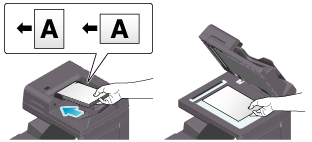
Tap [Scan to Email] on the home screen.
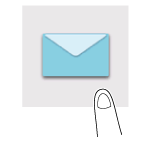
Specify the destination.
 For details on how to specify a destination, refer to [Specifying a Destination] .
For details on how to specify a destination, refer to [Specifying a Destination] .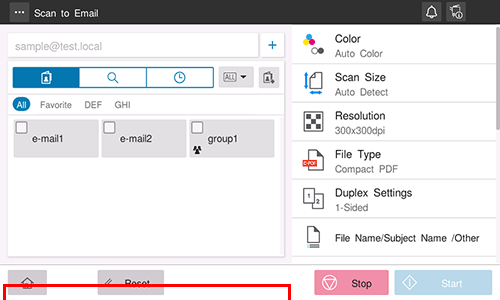
Specify transmission options as needed.
 For details on option settings, refer to [Transmission Option Settings] .
For details on option settings, refer to [Transmission Option Settings] .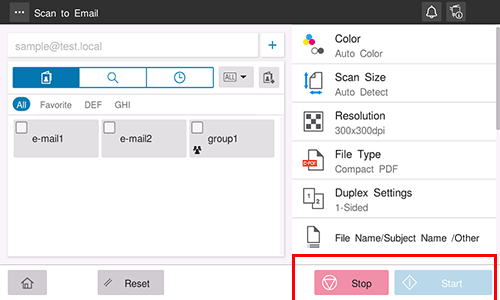
Use the Start key to start transmission.
 Using the Stop key enables you to stop scanning the original. A list of the currently stopped jobs is displayed. To stop transmission, select the target job from the list, and delete it.
Using the Stop key enables you to stop scanning the original. A list of the currently stopped jobs is displayed. To stop transmission, select the target job from the list, and delete it.
 Reference
Reference Changing the default option setting ( [Changing the Default Option Setting] )
Changing the default option setting ( [Changing the Default Option Setting] )
Specifying a Destination
Directly entering the destination
Directly enter destination information.
Tap [+].

Enter the destination's E-mail address.
Tap [OK].
 Tips
Tips [Prefix/Suffix] is displayed when [Prefix/Suffix Setting] ( [Prefix/Suffix Setting] ) is set. You can recall a registered domain name etc. to complement entry.
[Prefix/Suffix] is displayed when [Prefix/Suffix Setting] ( [Prefix/Suffix Setting] ) is set. You can recall a registered domain name etc. to complement entry.
Using Address Book
Selecting the Destination tab ( ) displays a list of destinations registered on this machine. Switch the display using an index, and specify the target destination.
) displays a list of destinations registered on this machine. Switch the display using an index, and specify the target destination.
Tapping the menu icon ( ) at the top allows you to switch the list of the registered destinations to the button or list view mode.
) at the top allows you to switch the list of the registered destinations to the button or list view mode.
There are two methods to specify a group destination; specifying the entire group and specify some destinations in the group.
To specify the entire group, select [Select All]. To specify some destinations in the group, select the desired destinations from the destinations registered in the group.
 Reference
Reference Registering Address Book ( [Registering Address Book] )
Registering Address Book ( [Registering Address Book] ) Registering a group destination ( [Registering a Group] )
Registering a group destination ( [Registering a Group] )
 Tips
Tips To specify multiple destinations, select [Restrict User Access], and set [Multiple Addresses Restriction Setting] ( [Restrict User Access] ) to OFF.
To specify multiple destinations, select [Restrict User Access], and set [Multiple Addresses Restriction Setting] ( [Restrict User Access] ) to OFF. To specify the entire group in Group, select [Restrict User Access], and set [Allow full selection of group destinations.] ( [Restrict User Access] ) to ON.
To specify the entire group in Group, select [Restrict User Access], and set [Allow full selection of group destinations.] ( [Restrict User Access] ) to ON.
Searching for the registered destination
Tapping the Search tab ( ) displays the destination search screen. If a large number of destinations are registered, the system searches for the registered name of the destination or characters of the address to find the target destination.
) displays the destination search screen. If a large number of destinations are registered, the system searches for the registered name of the destination or characters of the address to find the target destination.
Select the search method from [Name Search] and [Addr. Search].
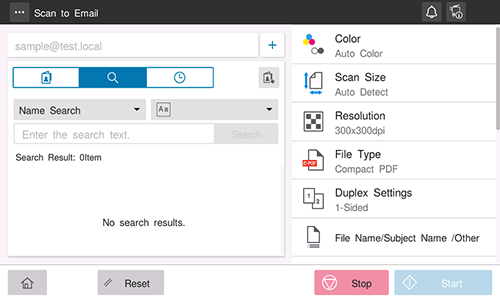
Enter the search word, and tap [Search].
Specify the target destination from the search result.
Specifying the target from the destinations registered in the LDAP server (LDAP Search)
Tapping the Search tab ( ) displays the destination search screen. If the LDAP server or the Active Directory of Windows Server is used for user management, you can search for (LDAP Search) destination information registered in the server and specify the desired destination.
) displays the destination search screen. If the LDAP server or the Active Directory of Windows Server is used for user management, you can search for (LDAP Search) destination information registered in the server and specify the desired destination.
 A presetting is required to use LDAP search. For details on the setting procedure, refer to [Configuring Settings to Search for a Destination via the LDAP Server] .
A presetting is required to use LDAP search. For details on the setting procedure, refer to [Configuring Settings to Search for a Destination via the LDAP Server] .
Select the LDAP search method.
 When using a single keyword for searching, select [LDAP addr Search].
When using a single keyword for searching, select [LDAP addr Search]. When combining search words by category for searching, select [Adv. Search (LDAP)].
When combining search words by category for searching, select [Adv. Search (LDAP)].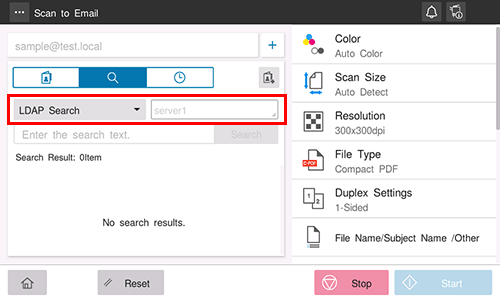
When multiple servers are registered, select the target server.
 Tapping the server name display area displays the server selection screen. Select the desired server, and also tap [OK].
Tapping the server name display area displays the server selection screen. Select the desired server, and also tap [OK].Enter the search word, and tap [Search].
Specify the target destination from the search result.
Using Job History
Tapping the History tab ( ) displays a list of transmission logs. Specify the target destination from the previous five job histories.
) displays a list of transmission logs. Specify the target destination from the previous five job histories.
 Tips
Tips If a registered destination or a User Box is edited or if the Main Power Switch is turned off or on, the log information is deleted.
If a registered destination or a User Box is edited or if the Main Power Switch is turned off or on, the log information is deleted.
Transmission Option Settings
- Selecting the color mode to scan the original (Color)
- Specifying the original size (Scan Size)
- Specifying the resolution to scan the original (Resolution)
- Specifying the file type used to save the scanned original data (File Type)
- Scanning a 2-sided original (Duplex Settings)
- Changing the file name, E-mail subject, or message text (Document Name/Subject/Other)
- Scanning a number of originals in several batches (Separate Scan)
- Scanning originals of different sizes (Mixed Original)
- Skipping blank pages (Blank Page Removal)
- Specifying the original loading direction (Original Direction)
- Selecting the appropriate image quality level for the original (Original Type)
- Adjusting the density to scan the original (Density)
- Adjusting the background density of the original to be scanned (Bkgd. Removal)
- Scanning an original that is thinner than plain paper (Thin Paper Original)
- Scanning originals with folds (Z-Folded Original)
Selecting the color mode to scan the original ([Color])
Select a color mode for scanning originals.
Setting | Description |
|---|---|
[Auto Color] | Automatically determines [Full Color] or [Gray Scale] to fit the original color when scanning the original. |
[Full Color] | Scans in full color regardless of whether the original is in color or in black and white. Select this option to scan originals of other than black and white and scanning color photos. |
[Gray Scale] | Scans in gray scale regardless of whether the original is in color or in black and white. Select this option to scan originals with many halftones, such as black and white photos. |
[Black and White] | Scans an original in black or white without using gray scales. Select this option to scan originals with distinct black and white areas, such as line drawings. |
Specifying the original size ([Scan Size])
When the size of the original is not detected correctly, specify the size of the original you want to scan.
Specifying the resolution to scan the original ([Resolution])
Select a resolution to use to scan the original.
Setting | Description |
|---|---|
[200 | Select this option to scan a standard original. |
[300 | Select this option to scan a standard original at a higher resolution. |
[400 | Select this option to scan originals containing small characters or drawings. |
[600 | Select this option to convert an original into a file of the maximum size. Select this option to scan an original such as a full color photo with a fine image quality level. |
Specifying the file type used to save the scanned original data ([File Type])
Select the file type used for saving the scanned original data.
Setting | Description |
|---|---|
[File Type] | Select the file type to be saved from the following:
|
[Page Separation] | When you want to separate a file for each page while the original consists of multiple pages, set [Page Separation] to ON. This is not available when [File Type] is set to [JPEG]. All pages are separated.
|
[Character Recognition] | Select ON to enable searching of a PPTX, DOCX, or XLSX file.
|
[Set PDF/A] | Select the compliance level to create a PDF file based on PDF/A. |
[Encrypt PDF] | Set to ON to encrypt a PDF file.
|
[Outline PDF] | Set to ON to outline a PDF when storing a file in Compact PDF format. The text is extracted from the original and converted into a vector image. |
[PDF Web Optimization] | Set to ON to create a PDF file optimized for Web display. If a PDF file is optimized to the Web display, the Web browser displays only the first page of a PDF file on the screen before loading all pages. |
[Searchable PDF] | Set to ON to create a searchable PDF file.
|
[Add digital signature to PDF] | Set to ON to add a signature (certificate) of this machine to a PDF file. Also, select the encryption level of the signature. |
[Add Stamp to PDF] | Select whether to combine a PDF as an image or text when printing the date/time, page number, and header/footer on the PDF. |
[PDF Document Properties] | Add meta- information such as a title or author as PDF file properties.
|
 Tips
Tips To use the following functions, an option is required. For details on the required option, refer to [Scan options] .
To use the following functions, an option is required. For details on the required option, refer to [Scan options] .
DOCX/XLSX of [File Type], [Character Recognition], [Set PDF/A], [Encrypt PDF], [PDF Web Optimization], [Searchable PDF], [Add digital signature to PDF], [PDF Document Properties]
Scanning a 2-sided original ([Duplex Settings])
Select whether to scan one side or both sides of the original.
Setting | Description |
|---|---|
[Simplex/Duplex] | Select the side to scan the original (Simplex/Duplex). |
[Binding Position] | When scanning both sides of the original, select the original binding position to prevent the binding positions from being reversed between the front and rear faces.
|
[Original Direction] | Specify the orientation to load the original. |
Changing the file name, E-mail subject, or message text ([Document Name/Subject/Other])
Change the file name of the scanned original. When sending by E-mail, you can specify the subject and text of the E-mail message and change the sender's E-mail address ("From" address).
Setting | Description |
|---|---|
[Document Name] | Change the file name of the scanned original. |
[Subject] | Change the subject of the E-mail. If fixed subject phrases are registered, you can select a subject from those registered. |
[From] | Change the sender's E-mail address. In normal circumstances, the E-mail address of the administrator is used as sender's E-mail address. If user authentication is installed on this machine, the E-mail address of the login user is used as sender's E-mail address. |
[Body] | Enter the message text of the E-mail. If fixed message text phrase is registered, you can select message text from those registered. |
Scanning a number of originals in several batches ([Separate Scan])
If the number of original sheets is so large that they cannot be loaded into the ADF at the same time, you can load them in several batches and handle them as one job. You can also scan the original using both ADF and Original Glass alternately.
Load the original.
 NOTICE
NOTICE Do not load more than 100 sheets (21-1/4 lb (80 g/m)) at a time into the Original Tray of the ADF, and do not load the sheets up to the point where the top of the stack is higher than the
Do not load more than 100 sheets (21-1/4 lb (80 g/m)) at a time into the Original Tray of the ADF, and do not load the sheets up to the point where the top of the stack is higher than the  mark. Doing so may cause an original paper jam, original damage, or ADF failure.
mark. Doing so may cause an original paper jam, original damage, or ADF failure.
Set [Separate Scan] to ON.

Use the Start key to start scanning.
Load the next original.
 If necessary, tap [Change Setting] to change the scan settings.
If necessary, tap [Change Setting] to change the scan settings.Use the Start key to start scanning.
Repeat steps 4 and 5 to scan all the originals.
After all originals have been scanned, select [Finish].
Use the Start key to start transmission.
Scanning originals of different sizes ([Mixed Original])
Even for an original with pages of different sizes, by using the ADF, you can scan data while detecting the size of each page. If the widths of the originals are the same, select [Same Width]. If the widths of the originals are different, select [Different Width].
Skipping blank pages ([Blank Page Removal])
When [Blank Page Removal] is specified to scan an original including blank pages using the ADF, blank pages are excluded from scan targets. Blank pages detected are not counted as original pages.
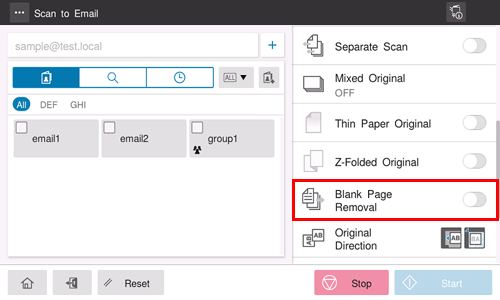
Specifying the original loading direction ([Original Direction])
When scanning a 2-sided original, specify the original loading direction so that the vertical direction of the scanned original is set correctly.
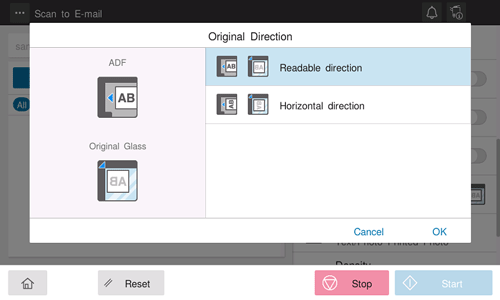
Selecting the appropriate image quality level for the original ([Original Type])
Select the optimum settings for the original to scan it in the optimum image quality.
Setting | Description |
|---|---|
[Text] | Scans an original that consists primarily of text at the optimum level of image quality. This function sharpens the edges of each character, creating easy-to-read images. |
[Text/Photo - Printed Photo] | Scans an original consisting primarily of text and photos at the optimum image quality level. This function sharpens the edges of each character and reproduces smoother photos. Select this option to scan printed originals such as brochures and catalogs. |
[Text/Photo - Photo Paper] | Scans an original consisting primarily of text and photos at the optimum image quality level. This function sharpens the edges of each character and reproduces smoother photos. Select this option to scan originals that include photos printed on photographic paper. |
[Photo - Printed Photo] | Scans an original consisting of only photos at the optimum image quality level. Select this option to scan printed originals such as brochures and catalogs. |
[Photo - Photo Paper] | Scans an original consisting of only photos at the optimum image quality level. Select this option to scan originals printed on photographic paper. |
[Dot Matrix Original] | Scans an original, which consists primarily of text such as thin or faint characters, at the optimum image quality level. This function reproduces text using high pixel density, creating easy-to-read text. |
[Copied Paper] | Scans an original, which is output with an even density from the copier or printer, at the optimum level of image quality. |
[Bar Code/Contract] | Reduces the file size when scanning the original such as a contract or bar code in black and white. If [Bar Code/Contract] is selected, [Color] is synchronously changed to [Black and White]. This option is available when the file type is set to TIFF or PDF. |
Adjusting the density to scan the original ([Density])
Adjust the density (Dark or Light) to scan the original.
Adjusting the background density of the original to be scanned ([Bkgd. Removal])
You can adjust the density of the background area for originals with colored backgrounds (newspaper, recycled paper, etc.) or originals that are so thin that text or images on the back would be scanned.
Setting | Description |
|---|---|
[Bleed Removal] | Adjust the density of the background color to prevent bleeding of the back of the paper when printing a 2-sided original that is so thin that the contents of the back side would be scanned. Selecting [Auto] automatically determines the density of the background color, and scans an original at the optimum background density level. |
[Discolor Adj.] | Adjust the density of the background color to scan an original with a colored background such as a map. Selecting [Auto] automatically determines the density of the background color, and scans an original at the optimum background density level. |
Scanning an original that is thinner than plain paper ([Thin Paper Original])
When scanning an original that is thinner than plain paper on the ADF, set this option to ON. This function reduces the original feed speed of the ADF to prevent thin paper from getting caught.

Scanning originals with folds ([Z-Folded Original])
If a folded original is loaded into the ADF, the original size may not be able be detected accurately. To scan the folded original on the ADF, set this option to ON.
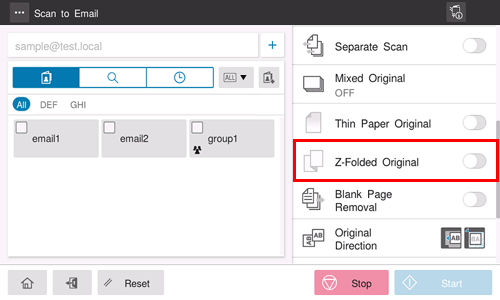
Changing the Default Option Setting
You can change the default option setting of basic style to the desired one.
 Before changing, select [Utility] - [Administrator] - [System Settings] - [Change Permission for Default Value Setting], and set [Change Permission for Default Value] to ON.
Before changing, select [Utility] - [Administrator] - [System Settings] - [Change Permission for Default Value Setting], and set [Change Permission for Default Value] to ON.
Tap the target function key on the home screen.
Change the target option setting to the value to be registered as the default.
Tap the menu icon in the upper left corner of the screen to display the menu. From this menu, select [Set the current setting value to Default value].
 To return to the factory default setting, select [Set the factory default setting value to Default value].
To return to the factory default setting, select [Set the factory default setting value to Default value].
The value specified in step 2 is set as the default.

